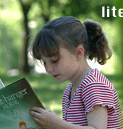Literacy interventions need to teach the conventions of writing
and the actions for manipulating this information. These actions
are the reading and writing strategies.
In this section we identify the reading strategies that are
useful to teach.
It is useful to think of the activity in which readers engage
in three phases:
| before reading |
while reading |
after reading |
| early stage of a reading act : getting ready or orienting |
while-reading stage: processing the text in depth |
post-reading or review stage |
Each phase requires readers to use their knowledge in particular
ways. There are actions readers use to get their knowledge
ready for reading a particular text, for making sense of the
text as they read and for learning from their reading activity.
Particular literacy knowledge and strategies can be taught
at each stage. Some of these are shown for each type of text
information in the following diagram, Readers can be taught
to use their knowledge systematically while reading by learning
what to do at each phase or stage during reading.
Stages of
reading
|
Levels of text processing |
| Dispositional level |
Topic level |
Conceptual level |
Sentence level |
Word level |
| Getting ready or orienting stage |
Focus on purposes for reading: Why am I reading text?
What will I look for as I read? What will I know when
I have finished reading?
Readers say how they will read, the strategies they will
use |
Link text with what reader knows; by using title, pictures.
What do I think text is about? What might the key ideas
be?
 phrases
phrases
 sentences
sentences
Extend knowledge necessary for understanding the text.
|
Link ideas in text with what you know, use mapping,
networking. What other ideas might come up with these?
What might happen next? What questions can I ask about
it?
 questions
questions
 infer
from sentences
infer
from sentences
 child's
story
child's
story |
Focus on how the ideas might be said: How would I
put these ideas into sentences?

How would I tell someone about them? |
What will I do as I read / come to a strange word?
 new
vocabulary
new
vocabulary
 keywords
and phrases
keywords
and phrases
 putting
the picture into words
putting
the picture into words |
- Readers say how they will read, the strategies they
will use. "What will I do as I read/come to a strange
word?"
- Am I ready to read?
|
| Teaching readers how to manipulate the text: While-reading
strategies |
Sentence level
- break text into digestible bits, decide where to
pause,
- listen to themselves as they read,
- act on ideas, put themselves in the context,

- paraphrase,
- visualise what was read,

- questions while reading,

- Does it make sense/fit in?
- re-read
Conceptual level
- summarise, What is the main idea so far?
- infer, Why did that happen?

- think ahead, predict, anticipate


- review and consolidate, What do I know now?
- underline, note down useful information
- relate them to what they expected
- gradually build an impression of the text.
Word level
- use context of word
 + initial few sounds
+ initial few sounds
- read to end of sentence and re-read
- use word analysis and re-read
- use meaning making motor (MMM)
|
| Post-reading or review stage |
Respond emotionally to text. How I liked the text?
Were ideas useful /interesting? Why was the text written?
 Respond
emotionally to text
Respond
emotionally to text |
Review text
understanding:
What did the text tell me?
 visualising and summarising
visualising and summarising
 summarising
(continued)
summarising
(continued)
 inferring
inferring
 through
questions
through
questions
Review, evaluate reading strategies used:
What reading actions worked?
 Reading Actions
Reading Actions

|
Learn by reading. What new ideas have been learnt;
how has reader's knowledge changed? What new ideas
will I remember? |
Add to their knowledge of language, for example, paraphrase
ideas in text, note new ways of saying ideas.
 |
What new words were in the text?
New letter clusters

|
The intervention needs to teach literacy knowledge and strategies
systematically at each stage or phase of reading.
| Teaching literacy knowledge and strategies
at each stage or phase of reading |
| early stage of reading: |
while-reading stage: |
post-reading or review stage: |
| teaching readers to 'get their knowledge
ready' for reading or 'orienting' what they know for reading. |
teaching readers how to comprehend or act on portions
of the text in depth at a time, to integrate as they read
and to predict. |
teaching readers how to integrate what they have read
into an overall understanding and to add it to what they
know. |

